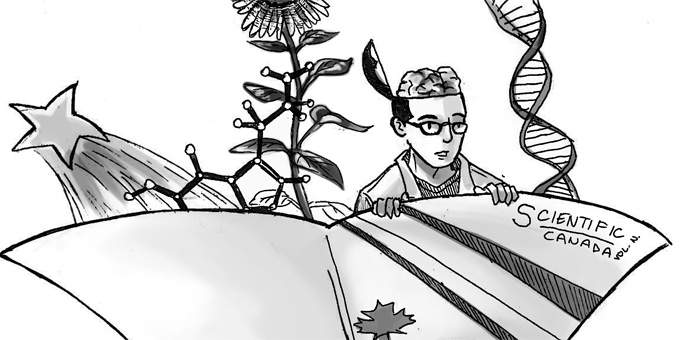Journalism has the ability to uncover, to elucidate, and to share a variety of viewpoints and truths. As Daily writers, we think that sharing viewpoints that are not often heard, or that often get drowned out or outright silenced, is of particular importance. And as science students, we are particularly interested in writing and reading about research. We’re charmed by the goings-on inside cells, by the workings of subatomic particles, by the way that the sky lights up all on its own when we’re far, far away from the city. We think that rational, calculated measurements of the world have the ability to deepen our understanding of it, and of ourselves. And (most importantly), we think that all of the nitpicky facts and specialized questions that research handles are inextricably tied to the lives we lead, and have a vast influence on the society we inhabit.
There is one thing about the impact of science that we know for certain: it’s messy, it’s nuanced, it’s hard to pin down. That’s why accurate, sensible and accessible science journalism is important, because it sure is easy to lose yourself — either as a reporter or a consumer — in a narrative that reduces the multitude of information available to something far less than the sum of their parts.
As consumers, our access to the latest research is often reduced to science that is ‘quirky’ and ‘fun.’ Stories about animals that have funny eyes, dinosaurs having sex — that sort of thing.
Don’t get us wrong: we don’t hate fun. We can’t stop listening to Taylor Swift’s “22” on repeat at the moment. But when ‘quirky’ has a monopoly on the market, it’s undermining. And it is a market, now more than ever a quick scramble to shake ducats out of the couch cushions as the smoke from the dying embers of print media starts to fill the living room. And fun shouldn’t be confused with sensationalism — though sensationalism sure does shake out more ducats.
Take the Popular Science feature from the September 2012 issue — an issue with a car on the cover — entitled “Labs that go BOOM.” Feminist blog Jezebel published on October 18 an article headlined “Turns out, baby blood might be the actual fountain of youth.” Even Scientific American, which calls itself “the leading source and authority for science, technology information, and policy for a general audience,” has fallen to the temptation of dramatic headlines at times. Sensationalist titles from past issues include: “Is Your Child Gay?” and “Microbes Manipulate Your Mind.”
And when big breakthroughs are made and reported on, we are given two choices: we can choose to consume the version published in Science or Nature, filled with graphs and acronyms most of the population are not equipped to decipher, or the version published in popular media, the version that glosses over facts and tries to lure us in with “Marijuana fights cancer” or asserts that eating an omelette is more dangerous than having a smoke. But what we want is the in-between: the factual but accessible narrative, devoid of complex statistics but also of overreaching headlines and sensational language.
This is, we know, a tall order. As current and former editors of this section, we know how hard it is to tease out truths, and incorporate them into narratives that are truly engaging, and equally truth-y. (And it turned out that Jonah Lehrer, the poster boy of spinning beautiful narratives, was making things up in order to do it.) It is hard when you’re filling a pitch quota to not go for the low-hanging fruit. But it’s frustrating for us to see the field devolving into an entity that is far from all that we feel it should be. It shows when we interview people: we have to convince sources that we’re not going to mangle their words; we have to explain that, yes, we are just as invested in not printing things that are not true about your lab as you are. It shows when we tell our science friends what we do — like maybe we’re out to take what they love and print a caricature of it in the newspaper.
So: be friendly to your neighbourhood science journalist. If you’re a scientist, make an effort to engage; if you’re a reader, don’t roll your eyes at all of us just because you read something you dislike on Gawker (we probably dislike it too!). And if you’re a writer, never, ever skimp on the facts to churn things out faster. (If you’re a freelancer — well, sometimes you have to take a paycheck where you can get it.)
Here is what we like: We like David Eagleman, explaining how the brain spins for us a seamless illusion of an imperfect reality. We like Alan Lightman’s prose, Richard Feynman (yeah, the sexist guy!) for his stories about puttering around Los Alamos, and Rebecca Skloot for uncovering the truth about HeLa cells. We like the days and years that come between publications, the second-guesses, the trials and errors, the outtakes.
Science is a beautiful, messy endeavour. Science writing, when done right, can help advance our society in the concerted human effort to understand our world. Science journalism connects us to a continual quest for knowledge, and in that endeavour, its reach can be incredibly wide — but it also has far to fall.
This article was a finalist in the opinion writing category of Canadian University Press’ John H. McDonald awards for excellence in student journalism. It was first published in The McGill Daily and is reprinted here with permission.
Photo: Edna Chan/The McGill Daily




